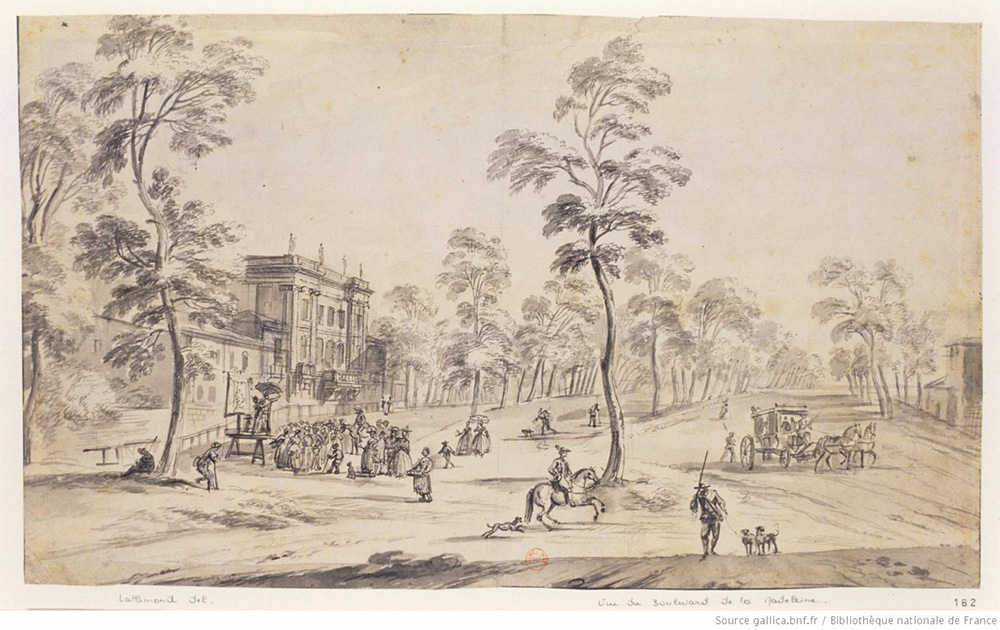The Beginning of Central Planning in Paris
Joan DeJean, How Paris Became Paris: The Invention of the Modern City (New York: Bloomsbury,2014), pp.9-11.
In London after the Great Fire of 1666, plans to modernize the devastated areas -- including one by Christopher Wren that closely followed the Parisian urban model -- were submitted to Charles II. But property owners concerned about their rights and taxes quickly began rebuilding. All thoughts of major change had to be abandoned. In Paris the combined efforts of a determined monarch and equally determined municipal authorities made it the first capital in modern history not to grow randomly from a village into an urban sprawl. Instead the new Paris became a vision of straight lines, right angles, and oblique radiating avenues -- a vision that shaped many cities to come, first in Europe and later well beyond. In 1698, an English visitor remarked: "The streets [of Paris] are so incomparably fair and uniform that you would imagine yourself rather in some Italian Opera . . . than believe yourself to be in a reall Citie."
Of all the public works then realized, one of them represented the biggest thinking of all, as historian of city governance Delamare first pointed out in 1705: "Until now, every ruler with authority over Paris has improved its fortifications to protect it from invasion." Because of Louis XIV's military victories, Delamare explained, "the capital no longer had anything to fear, and its fortifications thus became useless." Louis XIV had them torn down and, in their place, had a magnificent, tree-lined walkway laid out all around the city's rim: it became the original boulevard.
The Sun King was thus the first ruler to respond to the changing nature of warfare and of national defense: from the seventeenth century on, each European country's line of defense shifted from individual cities to the nation's perimeters. Louis XIV replaced an architecture of paranoia with an architecture of openness; he thereby made Paris the first open city in modern European history. This was a crucial step in the transition from the walled city to the modern cityscape.
The transformation of bulwarks into a green promenade was also by far the biggest public works project ever undertaken in Paris -- it was completed only by Louis XIV's successor and only in the 176os -- and one whose cost is not taken into account by critics who argue that Louis XIV lavished money solely on Versailles. Like many of the ideas that transformed Paris into a modern city, "the rampart," as Louis XIV originally named it, was financed jointly by the crown and the municipality. . . .
In many cases, however, the vast construction sites that dotted the face of Paris were not publicly financed. Henri IV had inherited a financial system as devastated as his capital. He could never have accomplished so much so quickly had he not turned to private investors, and his two successors followed his example. Many of Paris' quintessential landmarks -- the Place des Vosges, the Île Saint-Louis, the Place Vendôme , to name but one from each of the reigns -- began as royal visions and benefitted from royal support but were carried out on a for-profit basis by financiers and real-estate developers. . . .
Visionary urban works also altered the city's social fabric on an everyday basis. In 1600, Paris contained few spaces in which people from opposite ends of the economic spectrum interacted. But in the course of the seventeenth century, Paris' reinvention gave people places to go and sights to see. The experience of the city soon became far more physical and diverse when new attractions and a new ease of circulation encouraged Parisians to venture out of their homes and out of their neighborhoods, experiencing first-hand the city's size and its crowds. As they took in the ever-changing spectacle of the redesigned city, they might stand cheek-by-jowl and rub shoulders with people they would never previously have encountered.

Boulevard des Capucines Soon after its Creation in 1685